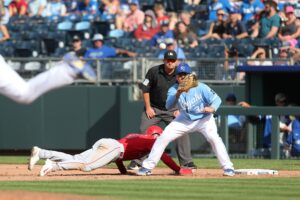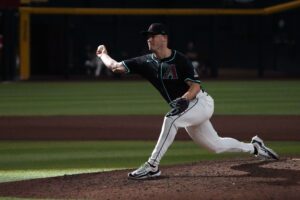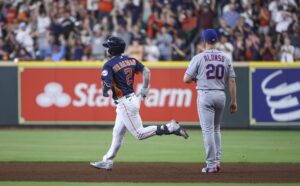The Josh Gibson Foundation, located in Pittsburgh, has been providing markers for unmarked graves of Negro League players. On Monday, they scratched two more off their list, when they provided markers for Clarence “Win” Harris and Frank Miller. Harris was a first baseman/left fielder for the Homestead Grays of the Black Baseball League on and off from 1918-24. Miller was a pitcher/left fielder for the Pittsburgh Keystones of the National Colored Baseball League in 1887 and the New York Gothams of the Middle States League in 1889.
Pittsburgh was a hotbed for Negro League baseball. Although the Negro Leagues Baseball Museum is situated in Kansas City, where the Monarchs played, Pittsburgh had two storied teams of its own. The Pittsburgh Crawfords existed from 1931-40, originating in the Crawford neighborhood of Pittsburgh’s predominantly black Hill District. They won Negro National League titles in 1935 and 1936. The Homestead Grays, winners of 11 league titles, were extant from 1912-50. They hailed from Homestead, a small borough outside Pittsburgh, just across the Monongahela River.
The all-time rosters of the Crawfords and Grays reflect much overlap. Together, they featured 16 members of the Baseball Hall of Fame, including Cool Papa Bell, Oscar Charleston, Martin Dihigo, Josh Gibson, Judy Johnson, and Satchel Paige. Today, Pittsburgh and Homestead are connected by the Homestead Grays Bridge. Entering Homestead from the bridge, one sees banners commemorating great Grays players. Entering Pittsburgh from the bridge, one sees banners honoring great Crawfords.
Aaron Will Tell You
Gibson, for whom the foundation is named, was one of the greatest players in the history of baseball. The Negro Leagues had a light schedule of official games. Thus, its players had opportunities to participate in more lucrative barnstorming and exhibition games. Its record-keeping was sketchy. As a result, its history is marred by tall tales. In 602 official and verifiable games, Gibson hit .373/.458/.718 with 166 home runs, 733 RBI, and an incredible 214 OPS+ while serving as a catcher, the most physically demanding position on the diamond. However, it’s believed he hit over 800 home runs. When asked 26 years ago whether it was true his father hit more home runs than Henry Aaron, Joshua Gibson told me, “Yes, he did, and one person who will tell you that is Hank Aaron!”
Lest anybody think that the Negro Leagues were somehow inferior to Major League Baseball, heed the words of Buck O’Neil. O’Neil was the first baseman/manager of the Monarchs. Thus, among others, he managed Paige and Jackie Robinson. O’Neil broke a color barrier of a different sort than Robinson, becoming the first black coach in the major leagues. The year was 1962 and the team was the Chicago Cubs.
In 1996, in Pittsburgh’s now-defunct Squirrel Hill Bookstore, O’Neil preceded his book signing with a lecture attended by this writer. He said that in exhibition games against MLB teams, the Negro League teams fared quite well. He noted that the Negro League teams had a built-in disadvantage because they couldn’t play as aggressively as the MLB teams could. Just imagine what would have ensued if a white player were injured by an inside pitch or a hard slide. Those elements of the game were taken away from the Negro Leaguers.
Unmarked Graves of Negro League Stars Getting Markers, Thanks to Josh Gibson Foundation
Writer Vince Ciaramella was bored. It was early in the coronavirus pandemic with nothing going on and nowhere to go in Pittsburgh. Thus, he went on a tour of Allegheny County cemeteries in search of baseball-related graves. Ciaramella found over 200 graves of baseball players, managers, executives, umpires, and owners. However, in searching for and locating the graves of Negro League players, he found that 18 of them were unmarked.
Meanwhile, a fan informed Sean Gibson, great-grandson of Josh, that the grave of Josh’s wife was unmarked. Sean serves as executive director of the Josh Gibson Foundation, which provides academic and athletic programs for youth. Sean never knew his great-grandmother’s grave was unmarked. Hence, with Ciaramella’s assistance, the foundation’s “Negro Leagues Memorial Markers” initiative was born. Since then, they’ve provided markers for 11 graves. They have nine more graves on their list. All of these graves are in Allegheny County.
Last night @KDKA– Pittsburgh News. Featured The Josh Gibson Foundation Grave Marker Project and Students from @Seneca_Valley Ryan Gloyer Middle School who raised over $800 for former Homestead Grays Player, Clarence James “Win” Harris’s Unmarked Grave 👇🏾https://t.co/i7HWuIRwky
— Sean Gibson (@JoshGibson_1911) May 14, 2024
The markers are inscribed with the player’s name at the top and “Negro Leagues Player” at the bottom. In between, from left to right, are the player’s date of birth, an illustration of a baseball, and the date of death. The initiative is similar to that taken on by SABR, which provides markers and headstones for the graves of 19th-century ballplayers whose graves either lack markers or are in “dire disrepair.” In Pittsburgh, the rusted iron grave of Pud Galvin was upgraded thanks to the SABR project. It boggles the mind that deceased MLB and Negro League players lay in unmarked graves. Who knows, maybe one day you’ll walk through a cemetery and come across the marker of a Negro League player and become inspired to learn about him.
Photo Credit: © Jerry Carino / USA TODAY NETWORK






